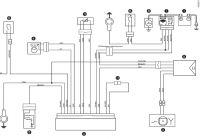Hello. Motor like the topic. No charging. Replaced stator and voltage regulator. Regulators tested in another motor are working properly (charging 14V). AC voltage on connected stator cables (yellow) 17,8V. Battery voltage (motorcycle fired) 11.8V. All cables and grounds checked. What else can cause a failure to charge? What is the fifth wire (white) coming out of the controller and going to the CDI module for? I enclose the installation diagram and photo of the regulator.
I will add that after disconnecting the black and white wire (responsible for charging) from the regulator and connecting the light bulb, the bulb shines lightly, voltage about 6V and drops to 4.5V after increasing the speed.



I will add that after disconnecting the black and white wire (responsible for charging) from the regulator and connecting the light bulb, the bulb shines lightly, voltage about 6V and drops to 4.5V after increasing the speed.





